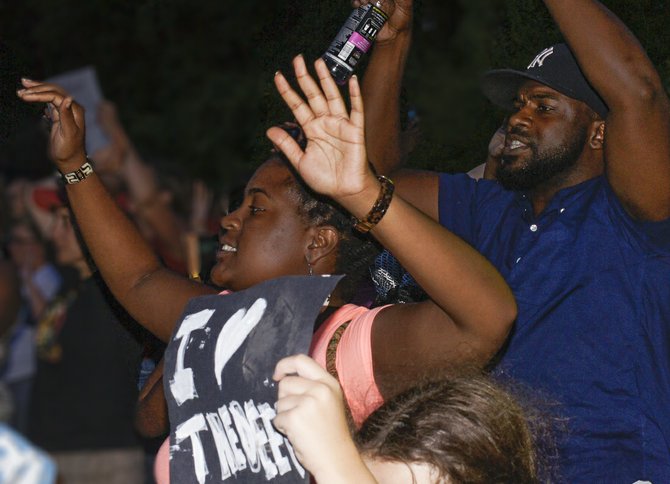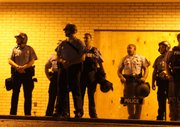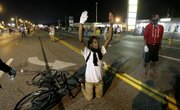Brittany Gray and Tyson Jackson, Jackson-area community activists, joined attorney C.J. Lawrence (not pictured) on a trip to Ferguson, Mo., over the weekend. They participated in a number of demonstrations in the case of unarmed black teenager Mike Brown, whom Ferguson police officer Darren Wilson shot and killed on Aug. 9. Photo by R.L. Nave.
FERGUSON, Mo.—The half-mile stretch of West Florissant Avenue, between Dellwood and Ferguson, Mo., is jammed with cars that are jammed with teenagers.
It's the end of the summer, just before midnight on Aug. 15, and for the kids who have not already started back to school, this is their final weekend to have a good time before classes start on Monday. And they are having a good time under the circumstances. Many of the vehicles cruising the popular strip a few miles north of the St. Louis City-St. Louis County dividing line are brimming with young, black bodies.
They're positioned on car doors, atop roofs and trunks, and in the beds of pickup trunks. Every horn is honking, and every other car is blaring the music of Lil Boosie, the Baton Rouge-based rapper released from prison earlier this year after serving a five-year sentence in a Louisiana state prison on drug charges.
For this generation of black teenagers, Boosie is their Tupac Shakur.
One week has passed since a boy named Michael Brown was shot and killed by a police officer here. New information about the shooting has come out every day, none of which has done much to help us understand why Mike Brown is dead or what is being done so that it doesn't happen to someone else. Thus, every night since the shooting, people have sojourned to Ferguson—many in cars, some on foot—in a ritual that is equal parts revelry and rebellion.
A Shrine and Anchor
Ferguson has drawn people from all over the country. A handful of people also reportedly flew in from overseas. I traveled to Ferguson with three activists from Jackson. Brittany Gray is a 28-year-old Greenwood native and doctoral student concentrating on the role of women in politics. Gray has a reputation for jumping in her car at a moment's notice to join a protest just about anywhere east of the Mississippi River as evidenced by the more than 87,000 miles displayed the odometer of her late-model car.
Tyson Jackson, 33, grew up in Champaign, Ill. Jackson served as a military policeman and lived in St. Louis, where he has family, before coming to Jackson in 2009.
C.J. Lawrence, 33, is an attorney and social-media wiz who formerly worked for the city and handled social media for the mayoral campaigns of both Chokwe Lumumba and his son, Chokwe Antar Lumumba. He made the trip after attracting international media attention for starting #iftheygunnedmedown, a Twitter hashtag that rebukes the media's frequent mishandling of stories involving the deaths of unarmed black teenagers.
Gray, Jackson and Lawrence all consider themselves acolytes of the late Mayor Lumumba, but each has a different way of thinking about their activism and varied reasons for going to Ferguson. Jackson, the former MP, thought of the trip as partly reconnaissance, an opportunity to assess and report back to social-justice activists in Jackson and come up with organizing strategies.
"Ninety per percent of me was going to help support the people of Ferguson. Ten percent of me believed it was a moment in history," Jackson told me.
Perhaps it was Jackson's military discipline or his training as an organizer—he has also been involved with workers' rights issues with the NAACP and United Auto Workers, but he was taken aback at the lack of organization of people protesting in Ferguson.
We made our way up West Florissant Avenue, parked and got out to look around and see for ourselves what was going on the ground, what we had been seeing on the news for several days. The QuikTrip gas station, one that I've visited a hundred times, was a burned-out shell. In its former life, the station was a kind of hub for the neighborhood. The gas was relatively cheap, and relatively safe.
Because of its location on West Florissant, one of the city's busiest thoroughfares, it was a frequent stop for police officers from municipalities around north St. Louis County.
Now it stands as a shrine and anchor for Mike Brown-related demonstrations. Some have started calling it Ferguson's Ground Zero. On the first night of protests, the day after Mike Brown was shot and killed and the night the QuikTrip burned, early news reports suggested that a peaceful vigil inexplicably devolved into violence, mayhem and looting.
But peaceful people don't become violent for no reason. We started to understand what happened a little better not long after we arrived. Our group pushed past the crowds of demonstrators—some wearing bandanas over their faces and hooded sweatshirts, some walking with children on their shoulders—as they chanted "Hands up! Don't shoot" and made our way to a front. There, a group of maybe 300 faced off with police dressed in riot gear and holding guns with bright orange butts to denote that these guns are not designed to be lethal.
Men from the Nation of Islam stood at the front for crowd control. They kept the protesters away from the police. There was the occasional chant of "F*ck 12," dispatcher code for police, but the demonstration was peaceful. The crowd cheered as police backed away and loaded into their vehicles, which protestors interpreted as retreat. Just then, for unknown reasons, whizzing canisters shooting white smoke clinked up the pavement toward the protesters.
Several explosions sent people running in every direction and taking cover. For those who have never been in a war zone or on the front line of a protest, it wasn't clear if the smoke was tear gas or if the police had opened fire on us.
As it turned out, it wasn't tear gas nor were we being shot at. Still, people were pissed off. The consensus was that it was a shady thing to do to citizens peacefully exercising their First Amendment rights of free assembly and speech.
Later that morning, after 2 a.m., people looted some of the stores on West Florissant, some of which had been boarded up since the first night of protest. The report on local TV news stations was that the protests had erupted into mayhem, but I and everyone else who was there knew there was more to the story.
'A Complicated Story'
The truth is, Ferguson is a complicated story to tell, and it's a complicated story to understand.
Part of what is fueling protests is the understanding of local people, especially young people, that the police, the most visible representation of local government, often treat people there badly.
Mike Brown was an extreme, but not an altogether unexpected, example of that mistreatment.
Brown, 18, and a friend were coming back from shopping at a local store—like Trayvon Martin and Jordan Davis before each of their deaths—when the police approached them. Now, the FBI is in charge of sorting out everything that happened after Brown was stopped while walking in the street and before Ferguson police officer Darren Wilson shot Brown six times, including twice in the head.
Young Ferguson residents report that tensions with police are always high, especially in the three apartment complexes situated just off West Florissant and just out of public view.
News outlets have pointed out that the apartment complex where Mike Brown was killed represents St. Louis' decades-long history of racial segregation that divides the city into a majority-white south St. Louis city and county and a majority-black north city and north county.
After the city's all-black downtown housing projects were torn down, many of their African American inhabitants settled in north St. Louis County, including Ferguson.
As Ferguson grew, it became one of the most racially diverse little cities in the St Louis metro. Many people consider Ferguson a nice place to live. It's the kind of place that many black families aspire to move to when they build up. In the early 1990s, my own grandmother moved to Ferguson from west St. Louis City.
But even though Ferguson became more diverse, the power structure in the city has remained all white. And no one really noticed until the Mike Brown shooting. I talked to my grandmother about that the next morning. In the 20 years she has lived in her house, where my father's side of the family gathers for holidays and other important celebrations, my grandmother has been troubled enough to call the police only once, to report a neighbor playing music too loudly on a Sunday morning.
"I didn't have no need to go to city hall," she told me over breakfast.
On Looting and Destroying
Even that is only part of the story. More evidence of nuance came later Saturday morning. I met up with Brittany at a McDonald's that a few days earlier had been the scene of the high-profile arrests of two journalists, one white and one African American. We headed across the street to Family Dollar to pick up rain gear. Outside, we talked to an African American woman who manages a beauty-supply store that was looted overnight for a Korean family.
The manager, a Mississippi native, spoke affectionately of the store's owner who she said is a good person with a kind heart who loves the neighborhoods and didn't deserve to be targeted by thieves. Ferguson is full of those kinds contradictions.
Some people say that the protesters are destroying their own community. Other people see many of the business owners as outsiders who do not have the interests of the community at heart.
There is the argument that looting and destroying business is not an appropriate way to express outrage or political discontent. Another school of thought is that what is happening in Ferguson is an understandable and perhaps even necessary reaction to human oppression.
Many believe Ferguson is completely lacking in leadership, discipline and organization, while others say there are too many leaders with dubious agendas (it is an election year in Missouri).
On Saturday, the Rev. Jessie Jackson led a march from the Canfield Green Apartments, where Mike Brown was killed, to a local church. Jackson drew criticism at the end of the march for sending around the collection plate to gather donations for the church.
The Rev. Al Sharpton has been in and out of St. Louis as well; so has Malik Shabazz of the New Black Panther Party and a frequent guest on cable news talk show.
Adofo Minka, founding attorney of the Law Center for Human Rights and Justice in Jackson, grew up close to Ferguson in nearby Jennings. Minka acknowledges that protesters may lack clear political direction or even political education, but he believes that, even in the absence of defined purpose, people have made a point.
"Who could really say how these things are supposed to be organized? This is a very chaotic situation. It seems like people are doing the best they can on the fly," Minka said.
See Part II in next week's issue.
See the JFP's full archive of Ferguson coverage here.




